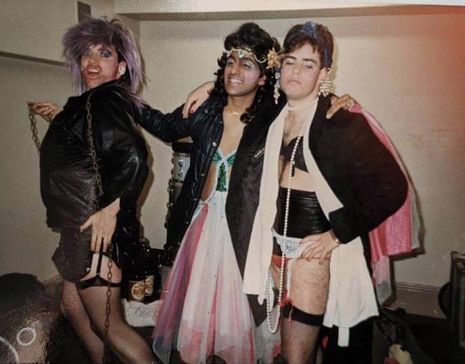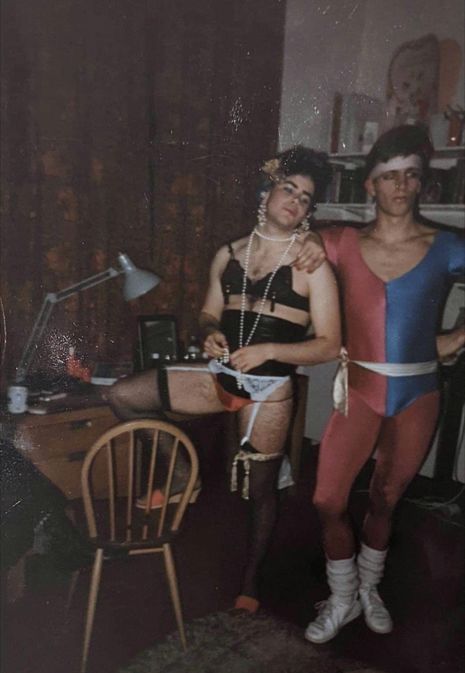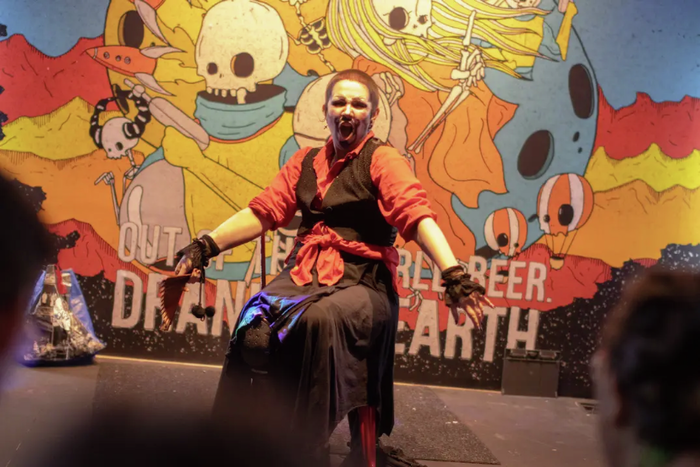Mx Pembroke: 36 years of drag and dancing
Alex Parnham-Cope investigates the mother-son Valencians who’ve brought pride and partying to one of Cambridge’s oldest colleges

The year is 1987. Rick Astley is blasting over the record player, Thatcher dwells in Number 10, and in Pembroke College, students are suiting up in leotards and leopard print to compete in the colleges first ever drag show. Sian Griffin, a second year Medicine student at the time, bundled her film camera into Pembroke cellars to capture some iconic shots from the evening. Then decades later, her son Oscar, now studying Classics at the same college, would stumble across the pictures and resurrect the tradition. Speaking to both mother and son, Varsity investigates 36 years of glitter and glam at Pembroke, and how drag has evolved from a light-hearted party to a politically-conscious expression of community and identity.
“Drag has evolved from a light-hearted party to a politically-conscious expression of community”
Setting the scene, Sian Griffin explains that she matriculated in 1985 – she was only the second year of women admitted to Pembroke since its founding in 1347, estimating that men outnumbered women in her year six to one. In the spring of 1987, she recalls that RAG week was marked with the college’s holding a drag competition in the cellars dubbed ‘Miss Pembroke’, with students donning their skimpiest suspenders and highest heels for a good cause.

Speaking to Sian, what is most apparent is the playful incongruity of the show. She explains that the students didn’t even consider it would cause offence or eyebrow-raising among the fellows, but rather simply “thought that if people thought it was funny they would come along.” The evening was presented by a compere, contestants in the parade introduced themselves and, naturally, were subjected to much hearty “audience participation”.
One thing that was unusual, she reflects, is that the “range of people who took part was quite unexpected, from someone you might have thought was quiet and relatively shy to a couple of more gregarious boaties”, concluding that the night had a “positive impact overall” in bringing the student body together. Still, Sian generally downplayed the political significance of the night’s festivities, pointing out that there wasn’t a wider drag community or culture at the time: “For the participants in Miss Pembroke it was a one night only appearance!”
“There were no expectations participants had to be queer or any good at it, it was just a fun night”
Like many of the best things in life, the renewed interest in the 1987 event was a happy accident. Oscar and his mum were going through old photo albums when they happened across the pictures she’d taken, which according to Oscar were “definitely surprising”, but “nice to see students putting their all into it and just having fun!”
As the current Pembroke LGBT officer, Oscar was keen to take advantage of this quirk of history and resurrect the drag competition for a new generation of Valencians, eager to don their false lashes and alarmingly towering stilettos. The event went ahead at the end of Lent term, with the organisers keen to emphasise the “amateur angle”: “there were no expectations participants had to be queer or any good at it, it was just a fun night.”
Indeed, this DIY, community-driven ethos was at the heart of both events, with Oscar underscoring that while he has “great respect for performers who put their all into really impressive outfits and performances”, ultimately “encouraging expression and transgression of gender norms” needn’t be professionalised or competitive. With tattered wigs passed between performers and the dazzling cacophony of a single set of rainbow lights blasting the walls of Pembroke cellars yet again, it’s clear Pembroke has stayed true to its noisy, novice roots.
“The focus has shifted back to its roots in Black queer ballroom, and there is a greater focus on drag as queer expression”
Comparing how drag has evolved as both an art form and a social spectacle, Oscar remarks that in 1987 Miss Pembroke “definitely wasn’t distinctly LGBT or queer – it was just a laugh to dress up for charity.” Comparatively, he explains that the rising popularity of drag in contemporary media, exemplified by shows such as RuPaul’s Drag Race, has meant “the focus has shifted back to its roots in Black queer ballroom, and there is a greater focus on drag as queer expression.” This keen awareness of the centrality of LGBT identities and history to drag performances is reflected in the subtle name change, from Miss Pembroke in 1987 to Mx Pembroke in 2023.
However, the increased visibility and celebration of drag culture has been combined with renewed political attacks and legal marginalisation of LGBT groups. Reflecting on these volatile changes, Oscar observes that increased visibility of drag has unfortunately “become tied up in trans “debates”, and circled back round to arguments about LGBT people not being around children, leading to situations like drag bans in the US.” While there has undoubtedly been clear progress in the equality and protection of LGBT groups in the past decades, it is equally clear that drag culture remains a critical flashpoint in contemporary social and political life.
Even after 36 years, drag still retains the power to shock and scandalise, but equally to bring like-minded souls together in celebration. For Oscar drag is an “art form and method of creative expression”; an act of gender transgression simultaneously intimate and deeply political. Whether it’s socially-minded performance art or just wildly tuneless karaoke, one thing’s for sure: the drag artists of Pembroke know how to put on a great show.
 Interviews / You don’t need to peak at Cambridge, says Robin Harding31 December 2025
Interviews / You don’t need to peak at Cambridge, says Robin Harding31 December 2025 News / Cambridge academics stand out in King’s 2026 Honours List2 January 2026
News / Cambridge academics stand out in King’s 2026 Honours List2 January 2026 Comment / What happened to men at Cambridge?31 December 2025
Comment / What happened to men at Cambridge?31 December 2025 News / Unions protest handling of redundancies at Epidemiology Unit30 December 2025
News / Unions protest handling of redundancies at Epidemiology Unit30 December 2025 News / Varsity’s biggest stories of 202531 December 2025
News / Varsity’s biggest stories of 202531 December 2025









